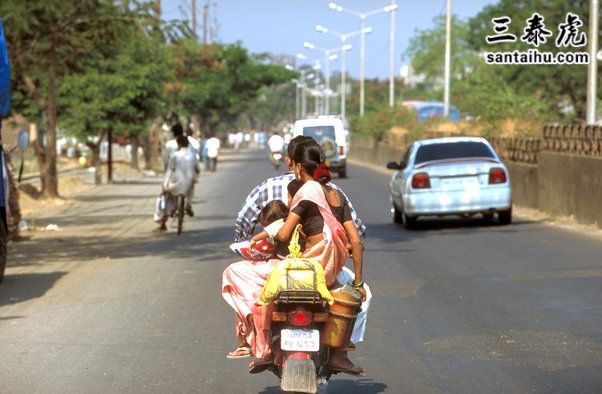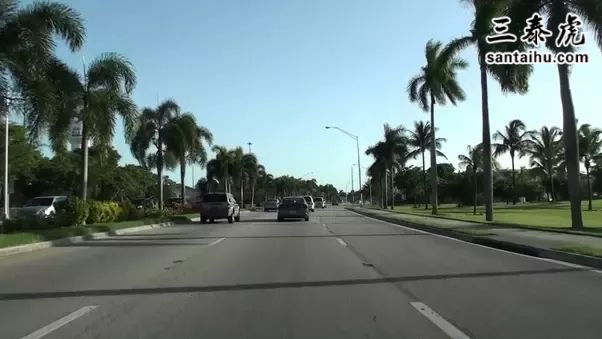Why do Indian roads have lot of dust while foreign roads are dust free?
为什么印度的道路有很多沙尘,其他国家的道路没有呢?
以下是Quora网友的评价:
Prasanna Bhalerao
Just look at this typical Indian road:
As you can see that the typical road in India has no hard shoulder and it does not have kerb, a cement edge that prevents loose soil to break and come over the road. This causes dust to creep in in hot summers while mud and sludge in rains.
On the other hand, consider this road in USA (typical of all western nations and where there are good roads):
Look at the hard shoulder, the paved edges fixed with concrete bricks called kerbs. After the kerb, there is a shoulder/pavement and there is grass which prevents dust formation. Well grass is a bonus in some US states and Europe. Many people have said that our roads are dusty because of heat and lack of rain. But go to the Middle East where similar, in fact worse, conditions exst. But there too there is no dust (unless there is a sandstorm). The reason is the same - absence or presence of hard shoulders and pavements.
看看这条典型的印度道路:

正如你所看到的,印度的典型道路没有硬路肩,也没有路缘石,这是一种水泥边缘,可以防止松散的土壤破裂并越过道路。这会导致灰尘在炎热的夏天蔓延进来,而在下雨时会有泥浆和污泥。
另一方面,看一下美国的这条道路(所有西方国家的典型道路,那里有好的道路):

看看坚硬的路肩,用称为路缘石的混凝土砖固定的铺砌边缘。路缘石后面是路肩/路面,还有草,可以防止灰尘形成。在美国的一些州和欧洲,铺满草皮是一种额外的加分。许多人说,由于高温和少雨,我们的道路尘土飞扬。但去中东,那里也存在类似的情况,甚至情况更糟。但那里也没有灰尘(除非有沙尘暴)。原因是相同的——没有或存在硬路肩和人行道。
Xupiter Monk
Just put grass sod everywhere in India wherever you see land and make sure people who own land need to Mowe it regularly and water, that grass sod keep hold of loose soil and dust. That’s all. 80% of USA land is covered with grass sod panted by human.
只需要在印度目之所及的土面上铺满草皮,保证人们定期进行修剪和浇水,草皮就可以控制松散的土壤和沙尘。这样问题就能解决了。美国80%的地面都被人工种植的草皮所覆盖。
Ananth S
India has 2 big deserts to her west, The Thar desert and the Sahara desert. The dust blows continuously even over the Arabian sea in the Sahara’s case, and this leads to millions of tonnes of sand and dust being blown. it has little to do with curbs or cleanliness. there are cities in India where you wouldn't find dust accumulated.
印度西部有两个大沙漠,塔尔沙漠和撒哈拉沙漠。沙尘持续不断地吹过阿拉伯海,吹走数百万吨的沙尘。这跟防控和清洁都没有什么关系。在印度某些城市,并不会出现沙尘堆积的现象。
Eye Ford
The only reason is because our Government doesn’t bother to have any dust control measures. Trucks will carry mud in an open condition. Building constructions are done without any covering for controlling dust, etc. Obviously we will have dust all over the place.
唯一的原因是印度政府没有采取任何防尘措施。卡车在露天条件下运泥,建筑施工没有任何覆盖物。所以显然,印度到处都是沙尘。
Amit M
It seems they construct the road on a lower level about 10 to 20 cm lower than the surrounding area. There seems no clear separation of a road and its surrounding area which may be houses or shops or just a agriculture field or any building or any open place. Due to wind or rain, the top soil and dust of surrounding area appears on roads. There are no underground sinks to drain rainwater or anything else on the side of any road. See it to believe it. The same wind or dust might be present in other countries but when it rains or when they wash the road, the roads appear clean with all the dust going into sinks on side of the roads.
印度似乎总在比周围地面低10到20厘米的地方建造道路。道路和周围地区似乎没有明确的界限,周围可能就是房屋、商店、农田或其他建筑或任何开放的地方。风雨会把周围表层的土壤和沙尘冲刷到道路上。道旁没有地下水槽来排泄雨水或其他东西。其他国家可能也会有大风或沙尘,但下雨或清洗道路时,道路会看起来很干净,所有的沙尘都能通过地下管网排出。
Civil engineering is at its worst in India. Civil engineers in india seem to just imitate british buildings from year 1900 or so and can’t really use any of their mind.
Over population seems to make things ugly just to make way while breaking all rules of engineering and shrink the road or make it sloppily for someone to be fed. People in india including lawmakers don't seem to accept sane reasons like above which are logically valid and can be verified.
Because of bad roads, almost all vehicles in india are speed limited with their top speed around 120 to 160 kmph where as in other countries, some vehicles go upto 300 kmph because they are not being speed limited.
印度的市政工程糟糕至极。印度的土木工程师似乎还在无脑照搬1900年左右的英国建筑。
人口过多也让事情愈加严重,为了满足人口需求打破所有工程条例,路面宽度缩水,粗制滥造让奸商中饱私囊。包括立法者在内的印度人似乎不接受上述合理、符合逻辑、不怕推敲的理由。
由于糟糕的道路状况,印度几乎所有车辆都必须限速,最高时速在120到160公里左右,但在其他国家,有些车辆的最高时速可达300公里,因为它们没有限速。
These seem more than a few million people in india with its 1 mlllion engineering graduates per year who believe they can do engineering and they can construct roads. Many people in india are not truthful although they have a national motto “truth only triumphs” .
印度每年有100万工程专业毕业生,他们相信自己可以做工程,可以修路。许多印度人不够诚信,尽管印度有句格言“唯有真理才能胜利”。
Venugopal Sistla
you please visit Visakhapatnam which has point to point roads. if there is no gap between road and footpath this dust problem does not arise. In spite of heavy sea and mountain winds Visakhapatnam roads are far better than average Indian city roads hence it was declared 3rd cleanest city last year.
你可以去维沙卡帕特南看看,那里有点对点的公路。如果道路和人行道之间没有间隙,就不会出现这种沙尘问题。尽管有海风和山风,维沙卡帕特南的路面状况远远好于印度其他城市的道路,所以在去年被评选为印度第三洁净城市。
Ravoori Ramachandran
Several reasons. Lot of construction work going on. Roads are not properly constructed. People throw waste materials around. Dust from polluting industries settle down. Vehicle pollution also adds up probably.
有以下几个原因。印度正在大量修建建筑工程。道路建设不合理。印度人随处乱扔垃圾。污染工业排放的沙尘慢慢沉降。另外汽车污染可能也会导致这个问题。
Amol Sapkal
Why you want answer?
If you would make a good road that last for years or centuries then how will the local contractors get contracts, indirectly how will a bill pass for the reconstruction if the roads are good.
I hope you have understood what I am trying to say!
你为什么想知道答案?
如果你想修一条能用上好几年或好几个世纪的优质公路,那么当地承包商上哪儿找生意呢,而且如果道路质量很高,道路重修的提案怎么能通过。
我希望你能明白我想说什么!
Anup Mohan
After doing my research for a couple of weeks, here is what I found-
在做了几个星期的研究之后,我把我的发现整理如下:
Unpaved Sides - Unpaved sides are used by our government agencies to lead rain water into sewage systems easily. It is a way to save their a**es during monsoon. You can refer to the picture below, I am referring to point 2. These unpaved sides on the sides of the roads also act as a garbage collection center for the roads. It is a way for municipal corporation workers to easily collect the garbage so that they don't have to go all the way to the center of the road for garbage collection. The roads are designed in a way such that garbage, water and everything else can automatically come towards the road side. This is intentionally done. You will also notice that it’s height is much lower than the normal road so that it is easier for the garbage to get stuck there. You see, there is an entire inefficient system/cycle here. In the end, last lane acts as a garbage lane.
未铺柏油的路面:印度证明使用未铺柏油的路面,可以很容易将雨水引入污水排放系统。这在季风季是很有帮助的。道路两侧位铺柏油的路面也变成了垃圾收集中心。这是方便市政公司工作人员收集垃圾的一种方式,这样他们就不必走到路中央来收集垃圾。道路的设计方式使垃圾、污水和其他任何东西都可以自动流向路边。这是有意设计的。而且路面高度比普通道路低得多,所以垃圾更容易聚集。最后,最旁边的车道就成了垃圾车道。
Lack of civic sense among citizens - In a typical Indian street, when shopkeepers open their shops in the morning, they clean their shop and use the broom to divert all the dust outside, on the road, which then flies in the air. These are some dust collection points. And, then the wind does its work.
公民缺乏公民意识—印度街道边的店主早上开门营业时会打扫商店,用扫帚把所有的沙尘扫到店门外的路面上,然后这些沙尘就会飞到空中,然后风就开始发挥威力了。
No Maintenance - In Beiing (where I live), I can see road cleaning machines working 24*7. They are always working. They efficiently understand the traffic flow to decide their path in the day and night, most importantly they use incredibly high amount of water. Many times, I saw those machines cleaning roads in Delhi & Mumbai. There are 3 reasons they fail- a) They mostly work in the night. Instead, they can utilize less used roads to be cleaned in the day time since we don’t have enough machines. They are expensive. b) Less usage of water. c) Not using water leads to the dust flowing from one side of the road to another and another and another. In reality, there was no cleaning since they use air pumps and no water. d) It takes years to to get our roads fixed that have broken dividers or potholes.
缺乏养护—我在北京可以看到道路清扫机24*7全天候工作。我在德里和孟买也多次看到这些机器清洁道路,但效果不好的原因有三个:a)它们基本都在夜间工作。印度的道路清扫机不够多(因为机器很贵),应该在白天清扫车流量较小的道路。b)用水量不够。c)不用水冲,会导致沙尘从路的一边飘到另一边,到处飘。实际上只用气泵不用水,是起不到清洁效果的。d)我们的道路出现坑洼,要花上几年的时间才能修好。
No sense of Greenery- Trees don’t just give us oxygen/make a road look beautiful but also act as a natural barricade to dust and strong wind. The thick green foliage of grass and dense shrubs can be quite effective in stop the dust from getting mixed in the air. The problem with Indian roads are - a) Trees are not planted, they naturally grow in India. The problem in such case is that the wind finds barricades since it doesn’t find a clear path for it take the dust away. I have seen something new across many cities in the world that trees are grown outside the city and they are carried in a truck, lifted by a crane and then kept in their designated place on the street. Thus, giving an organized look to the street. In this organized approach, the wind finds a clear way without any hindrance for it to take the dust away. b) We practically don’t have any system for tree leaf collection. The problem is that they carry dust with them.
缺乏绿化意识—树木不仅可以为我们提供氧气/美化道路景观,而且还是沙尘和强风的天然屏障。浓密的绿叶草和茂密的灌木可以有效地阻止沙尘混入空气中。印度道路的问题是—a)树木并非人工种植,而是自然生长的。在这种情况下,风找不到通道来带走沙尘。世界上的许多城市会在郊区种植树木,用卡车运来到指定位置种植,街道就有了整齐的外观。风可以顺畅地通过通道把沙尘带走。b)我们没有清扫树叶的做法,而树叶就带着沙尘。
Poor Quality Raw Material - You will be shocked to know that according to road construction laws in India, the builder has no accountability for the roads. Basically, the accountability only exsts on the toll roads. All the city roads are not tolled, thus a constant scam keeps happening where the contractor applies as less concrete as possible. The problem is that - 1) Regular potholes and broken roads create dust. 2) Construction itself creates dust since we don’t have construction prevention laws in India.
劣质的原材料—你会震惊地发现,根据印度的道路建设法,承建商对道路质量不用担责。问责制只存在于收费公路上,但所有的城市道路都不收费,因此这造成了不断发生的骗局,承建商会尽可能少使用混凝土,所以问题来了—1)普通的坑洞和破损的路面会产生沙尘。2)修路本身也会产生沙尘,因为印度没有建筑防治法。
Poor Civic Planning- Unplanned urbanization has created a lot of buildings in our cities. However, there was no research/planning on its affects. This has led to - 1) A lot of concrete walls in our cities without having enough space for wind flow. 2) Lack of Construction Prevention Rules - Globally, construction requires protection, basically all the construction has to be covered. You may have seen some buildings covered in green cloth, that’s a way to prevent the dust flow. In India, we don’t follow such rules for road construction and house construction, instead we occupy the entire road in front of the house as a private storage area for construction equipments and material. 3) Lastly, most of the roads are not access-controlled i.e. without boundaries.
城市规划无序—杂乱无序的城市化带来了许多建筑,这导致了—1)城市里的许多混凝土墙没有足够的空间让风流动。2)缺乏施工防范规则—在全球范围内施工都需要保护,基本上所有施工现场都必须进行遮盖。你可能看过有些建筑物被绿布覆盖,这是一种防止沙尘流动的方法。在印度,我们的道路建设和房屋建设不会遵循这样的规定。3)最后,大多数道路没有进出限制,没有边界。
Old Vehicles- This is one problem which I see that the government is trying to solve, at least in Delhi. Old vehicles specially trucks, create a lot of pollution. India has one of the largest number of old vehicles that should have been banned way too early but currently are still on the roads.
老旧车辆—这是政府试图解决的一个问题,至少在德里是这样。老旧车辆,尤其是卡车,制造了大量的污染。印度是旧车数量最多的国家之一,这些旧车早就应该被禁行了,但目前仍可在路上行驶。
此文由 三泰虎 编辑,未经允许不得转载!:首页 > 资讯 » 为什么印度的道路尘土飞扬,其他国家的道路不会这样
 美媒:为什么中国要在美国道路上测试自动驾驶汽车,中企在加州的测试里程已经超过160万公里
美媒:为什么中国要在美国道路上测试自动驾驶汽车,中企在加州的测试里程已经超过160万公里 如何成为发达国家,IMF副总裁吉塔·戈皮纳特给印度指明了一条道路
如何成为发达国家,IMF副总裁吉塔·戈皮纳特给印度指明了一条道路 美国要禁止自动驾驶汽车使用中国软件,禁止中国自动驾驶汽车在美国进行道路测试
美国要禁止自动驾驶汽车使用中国软件,禁止中国自动驾驶汽车在美国进行道路测试 山东临沂遭遇猛烈暴雨,道路积水严重,一辆电动汽车竟在众人瞩目下变身“潜艇”
山东临沂遭遇猛烈暴雨,道路积水严重,一辆电动汽车竟在众人瞩目下变身“潜艇” 沙尘暴、暴雨袭击孟买,广告牌倒塌造成至少35人受伤
沙尘暴、暴雨袭击孟买,广告牌倒塌造成至少35人受伤 拉达克道路事故,致9名印度士兵死亡,包括一名初级军官
拉达克道路事故,致9名印度士兵死亡,包括一名初级军官 印媒:中国走在重新开放的道路上,发布防疫“新十条”
印媒:中国走在重新开放的道路上,发布防疫“新十条” 印度一名外科医生计划将子宫移植给一名变性女性,有望为生物男性怀孕铺平道路
印度一名外科医生计划将子宫移植给一名变性女性,有望为生物男性怀孕铺平道路